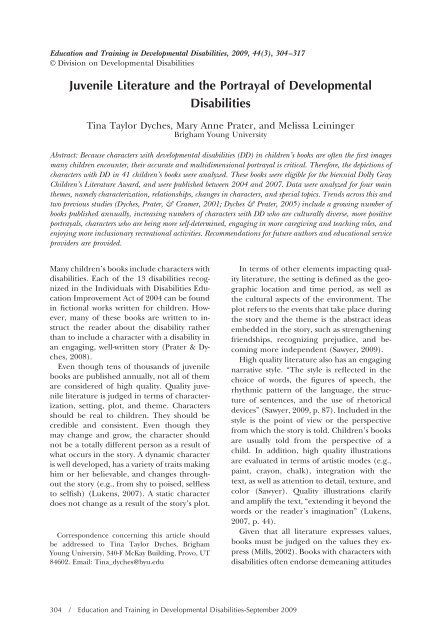Education and Training in Developmental Disabilities - Division on ...
Education and Training in Developmental Disabilities - Division on ...
Education and Training in Developmental Disabilities - Division on ...
You also want an ePaper? Increase the reach of your titles
YUMPU automatically turns print PDFs into web optimized ePapers that Google loves.
<str<strong>on</strong>g>Educati<strong>on</strong></str<strong>on</strong>g> <str<strong>on</strong>g>and</str<strong>on</strong>g> <str<strong>on</strong>g>Tra<str<strong>on</strong>g>in</str<strong>on</strong>g><str<strong>on</strong>g>in</str<strong>on</strong>g>g</str<strong>on</strong>g> <str<strong>on</strong>g>in</str<strong>on</strong>g> <str<strong>on</strong>g>Developmental</str<strong>on</strong>g> <str<strong>on</strong>g>Disabilities</str<strong>on</strong>g>, 2009, 44(3), 304–317<br />
© <str<strong>on</strong>g>Divisi<strong>on</strong></str<strong>on</strong>g> <strong>on</strong> <str<strong>on</strong>g>Developmental</str<strong>on</strong>g> <str<strong>on</strong>g>Disabilities</str<strong>on</strong>g><br />
Juvenile Literature <str<strong>on</strong>g>and</str<strong>on</strong>g> the Portrayal of <str<strong>on</strong>g>Developmental</str<strong>on</strong>g><br />
<str<strong>on</strong>g>Disabilities</str<strong>on</strong>g><br />
T<str<strong>on</strong>g>in</str<strong>on</strong>g>a Taylor Dyches, Mary Anne Prater, <str<strong>on</strong>g>and</str<strong>on</strong>g> Melissa Le<str<strong>on</strong>g>in</str<strong>on</strong>g><str<strong>on</strong>g>in</str<strong>on</strong>g>ger<br />
Brigham Young University<br />
Abstract: Because characters with developmental disabilities (DD) <str<strong>on</strong>g>in</str<strong>on</strong>g> children’s books are often the first images<br />
many children encounter, their accurate <str<strong>on</strong>g>and</str<strong>on</strong>g> multidimensi<strong>on</strong>al portrayal is critical. Therefore, the depicti<strong>on</strong>s of<br />
characters with DD <str<strong>on</strong>g>in</str<strong>on</strong>g> 41 children’s books were analyzed. These books were eligible for the biennial Dolly Gray<br />
Children’s Literature Award, <str<strong>on</strong>g>and</str<strong>on</strong>g> were published between 2004 <str<strong>on</strong>g>and</str<strong>on</strong>g> 2007. Data were analyzed for four ma<str<strong>on</strong>g>in</str<strong>on</strong>g><br />
themes, namely characterizati<strong>on</strong>, relati<strong>on</strong>ships, changes <str<strong>on</strong>g>in</str<strong>on</strong>g> characters, <str<strong>on</strong>g>and</str<strong>on</strong>g> special topics. Trends across this <str<strong>on</strong>g>and</str<strong>on</strong>g><br />
two previous studies (Dyches, Prater, & Cramer, 2001; Dyches & Prater, 2005) <str<strong>on</strong>g>in</str<strong>on</strong>g>clude a grow<str<strong>on</strong>g>in</str<strong>on</strong>g>g number of<br />
books published annually, <str<strong>on</strong>g>in</str<strong>on</strong>g>creas<str<strong>on</strong>g>in</str<strong>on</strong>g>g numbers of characters with DD who are culturally diverse, more positive<br />
portrayals, characters who are be<str<strong>on</strong>g>in</str<strong>on</strong>g>g more self-determ<str<strong>on</strong>g>in</str<strong>on</strong>g>ed, engag<str<strong>on</strong>g>in</str<strong>on</strong>g>g <str<strong>on</strong>g>in</str<strong>on</strong>g> more caregiv<str<strong>on</strong>g>in</str<strong>on</strong>g>g <str<strong>on</strong>g>and</str<strong>on</strong>g> teach<str<strong>on</strong>g>in</str<strong>on</strong>g>g roles, <str<strong>on</strong>g>and</str<strong>on</strong>g><br />
enjoy<str<strong>on</strong>g>in</str<strong>on</strong>g>g more <str<strong>on</strong>g>in</str<strong>on</strong>g>clusi<strong>on</strong>ary recreati<strong>on</strong>al activities. Recommendati<strong>on</strong>s for future authors <str<strong>on</strong>g>and</str<strong>on</strong>g> educati<strong>on</strong>al service<br />
providers are provided.<br />
Many children’s books <str<strong>on</strong>g>in</str<strong>on</strong>g>clude characters with<br />
disabilities. Each of the 13 disabilities recognized<br />
<str<strong>on</strong>g>in</str<strong>on</strong>g> the Individuals with <str<strong>on</strong>g>Disabilities</str<strong>on</strong>g> <str<strong>on</strong>g>Educati<strong>on</strong></str<strong>on</strong>g><br />
Improvement Act of 2004 can be found<br />
<str<strong>on</strong>g>in</str<strong>on</strong>g> ficti<strong>on</strong>al works written for children. However,<br />
many of these books are written to <str<strong>on</strong>g>in</str<strong>on</strong>g>struct<br />
the reader about the disability rather<br />
than to <str<strong>on</strong>g>in</str<strong>on</strong>g>clude a character with a disability <str<strong>on</strong>g>in</str<strong>on</strong>g><br />
an engag<str<strong>on</strong>g>in</str<strong>on</strong>g>g, well-written story (Prater & Dyches,<br />
2008).<br />
Even though tens of thous<str<strong>on</strong>g>and</str<strong>on</strong>g>s of juvenile<br />
books are published annually, not all of them<br />
are c<strong>on</strong>sidered of high quality. Quality juvenile<br />
literature is judged <str<strong>on</strong>g>in</str<strong>on</strong>g> terms of characterizati<strong>on</strong>,<br />
sett<str<strong>on</strong>g>in</str<strong>on</strong>g>g, plot, <str<strong>on</strong>g>and</str<strong>on</strong>g> theme. Characters<br />
should be real to children. They should be<br />
credible <str<strong>on</strong>g>and</str<strong>on</strong>g> c<strong>on</strong>sistent. Even though they<br />
may change <str<strong>on</strong>g>and</str<strong>on</strong>g> grow, the character should<br />
not be a totally different pers<strong>on</strong> as a result of<br />
what occurs <str<strong>on</strong>g>in</str<strong>on</strong>g> the story. A dynamic character<br />
is well developed, has a variety of traits mak<str<strong>on</strong>g>in</str<strong>on</strong>g>g<br />
him or her believable, <str<strong>on</strong>g>and</str<strong>on</strong>g> changes throughout<br />
the story (e.g., from shy to poised, selfless<br />
to selfish) (Lukens, 2007). A static character<br />
does not change as a result of the story’s plot.<br />
Corresp<strong>on</strong>dence c<strong>on</strong>cern<str<strong>on</strong>g>in</str<strong>on</strong>g>g this article should<br />
be addressed to T<str<strong>on</strong>g>in</str<strong>on</strong>g>a Taylor Dyches, Brigham<br />
Young University, 340-F McKay Build<str<strong>on</strong>g>in</str<strong>on</strong>g>g, Provo, UT<br />
84602. Email: T<str<strong>on</strong>g>in</str<strong>on</strong>g>a_dyches@byu.edu<br />
304 / <str<strong>on</strong>g>Educati<strong>on</strong></str<strong>on</strong>g> <str<strong>on</strong>g>and</str<strong>on</strong>g> <str<strong>on</strong>g>Tra<str<strong>on</strong>g>in</str<strong>on</strong>g><str<strong>on</strong>g>in</str<strong>on</strong>g>g</str<strong>on</strong>g> <str<strong>on</strong>g>in</str<strong>on</strong>g> <str<strong>on</strong>g>Developmental</str<strong>on</strong>g> <str<strong>on</strong>g>Disabilities</str<strong>on</strong>g>-September 2009<br />
In terms of other elements impact<str<strong>on</strong>g>in</str<strong>on</strong>g>g quality<br />
literature, the sett<str<strong>on</strong>g>in</str<strong>on</strong>g>g is def<str<strong>on</strong>g>in</str<strong>on</strong>g>ed as the geographic<br />
locati<strong>on</strong> <str<strong>on</strong>g>and</str<strong>on</strong>g> time period, as well as<br />
the cultural aspects of the envir<strong>on</strong>ment. The<br />
plot refers to the events that take place dur<str<strong>on</strong>g>in</str<strong>on</strong>g>g<br />
the story <str<strong>on</strong>g>and</str<strong>on</strong>g> the theme is the abstract ideas<br />
embedded <str<strong>on</strong>g>in</str<strong>on</strong>g> the story, such as strengthen<str<strong>on</strong>g>in</str<strong>on</strong>g>g<br />
friendships, recogniz<str<strong>on</strong>g>in</str<strong>on</strong>g>g prejudice, <str<strong>on</strong>g>and</str<strong>on</strong>g> becom<str<strong>on</strong>g>in</str<strong>on</strong>g>g<br />
more <str<strong>on</strong>g>in</str<strong>on</strong>g>dependent (Sawyer, 2009).<br />
High quality literature also has an engag<str<strong>on</strong>g>in</str<strong>on</strong>g>g<br />
narrative style. “The style is reflected <str<strong>on</strong>g>in</str<strong>on</strong>g> the<br />
choice of words, the figures of speech, the<br />
rhythmic pattern of the language, the structure<br />
of sentences, <str<strong>on</strong>g>and</str<strong>on</strong>g> the use of rhetorical<br />
devices” (Sawyer, 2009, p. 87). Included <str<strong>on</strong>g>in</str<strong>on</strong>g> the<br />
style is the po<str<strong>on</strong>g>in</str<strong>on</strong>g>t of view or the perspective<br />
from which the story is told. Children’s books<br />
are usually told from the perspective of a<br />
child. In additi<strong>on</strong>, high quality illustrati<strong>on</strong>s<br />
are evaluated <str<strong>on</strong>g>in</str<strong>on</strong>g> terms of artistic modes (e.g.,<br />
pa<str<strong>on</strong>g>in</str<strong>on</strong>g>t, cray<strong>on</strong>, chalk), <str<strong>on</strong>g>in</str<strong>on</strong>g>tegrati<strong>on</strong> with the<br />
text, as well as attenti<strong>on</strong> to detail, texture, <str<strong>on</strong>g>and</str<strong>on</strong>g><br />
color (Sawyer). Quality illustrati<strong>on</strong>s clarify<br />
<str<strong>on</strong>g>and</str<strong>on</strong>g> amplify the text, “extend<str<strong>on</strong>g>in</str<strong>on</strong>g>g it bey<strong>on</strong>d the<br />
words or the reader’s imag<str<strong>on</strong>g>in</str<strong>on</strong>g>ati<strong>on</strong>” (Lukens,<br />
2007, p. 44).<br />
Given that all literature expresses values,<br />
books must be judged <strong>on</strong> the values they express<br />
(Mills, 2002). Books with characters with<br />
disabilities often endorse demean<str<strong>on</strong>g>in</str<strong>on</strong>g>g attitudes

















